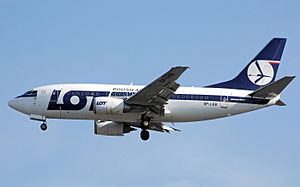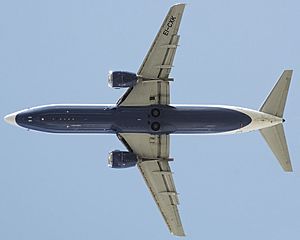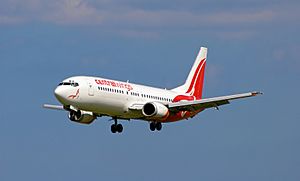Boeing 737 Classic facts for kids
Quick facts for kids Boeing 737 ClassicBoeing 737-300/-400/-500 |
|
|---|---|
 |
|
| British Airways 737-400 | |
| Role | Airliner |
| Manufacturer | Boeing Commercial Airplanes |
| First flight | February 24, 1984 |
| Introduction | November 28, 1984 with USAir |
| Status | In service |
| Produced | 1981–2000 |
| Number built | 1,998 |
| Developed from | Boeing 737 |
| Variants | Boeing 737 Next Generation |
The Boeing 737 Classic is a group of airplanes from the famous Boeing 737 family. This group includes three main types: the Boeing 737-300, 737-400, and 737-500. These planes were built between 1984 and 2000. A total of 1,988 of these aircraft were made.
They were not always called "Classic." When Boeing created a newer group of planes, the Boeing 737 Next Generation, these older models became known as the "Classics." Before that, they were simply called the "new generation" of 737s.
Contents
Developing the Classic 737s
After making the Boeing 737-200 Advanced, Boeing wanted to build a 737 that could carry more passengers. They also wanted it to fly longer distances. So, Boeing started designing the 737 Classic series in 1979. They shared information about these new planes at the Farnborough Airshow in 1980.
New Engines for the 737 Classic
A big change for the 737 Classics was their new CFM56 turbofan engines. These engines were a huge improvement. They used less fuel and made much less noise than older engines.
However, there was a challenge. The bottom of the 737 plane is quite close to the ground. This meant the new, larger engines would be too close to the ground if placed normally. Boeing and CFMI found a clever solution. They placed the engine slightly in front of the wing, instead of directly below it. They also moved some engine parts to the side instead of the bottom. Because of these changes, the front of the 737 Classic engines are not perfectly round.
Wing and Cabin Improvements
The wings of the 737 Classic also got many updates. The very tip of the wing was made longer by about 9 inches (23 cm). The flaps, which help the plane take off and land, were also improved.
Inside the plane, the cockpit where the pilots sit was made more modern. The passenger cabin also received updates. These improvements were similar to those made on the Boeing 757, another Boeing airplane.
Types of 737 Classic Airplanes
The 737-300 Model

The very first 737-300, called a prototype, was finished on January 17, 1984. It took its first flight on February 24, 1984. The plane was officially approved to fly on November 14, 1984.
USAir was the first airline to receive a 737-300. This happened on November 28, 1984. The 737-300 became very popular with airlines. Boeing received 252 orders for it in 1985 alone. In total, over 1,000 of these planes were ordered. The 737-300 was built until 1999. The last one was delivered to Air New Zealand on December 17, 1999.
In 2008, Southwest Airlines asked Boeing to update their 737-300s. They wanted to add new technology to make them more like the newer 737-700 models.
The 737-400 Model
The 737-400 was designed to fit between the 737-300 and the larger 757-200. It competed with planes like the Airbus A320 and McDonnell Douglas MD-80. The 737-400 was about 10 feet (3.45 meters) longer than the 737-300. It could carry up to 168 passengers.
This model had a special bumper on its tail. This was to prevent the tail from scraping the ground during takeoff. The first 737-400 was finished on January 26, 1988. It flew for the first time on February 19, 1988.
The 737-400 started flying for airlines on September 15, 1988. Piedmont Airlines was the first airline to use it.
There was also a version called the 737-400F. This was a 737-400 designed to carry cargo instead of passengers. Boeing did not build these directly. Instead, airlines would change their passenger 737-400s into cargo planes themselves. Alaska Airlines was the first to do this. Their 737-400F could carry 10 large cargo containers. Alaska Airlines also changed some of their 737-400s to carry both passengers and cargo. The 737-400 has since been replaced by the newer 737-800.
The 737-500 Model
The 737-500 was created to replace the older 737-200 model. It was made because customers specifically asked for it. The 737-500 is about 1 foot 7 inches (47 cm) longer than the 737-200. It can carry up to 132 passengers.
Airlines could choose to have either modern or older style cockpits installed on the 737-500. Using the CFM56-3 engine meant it used much less fuel than the engines on the old 737-200s.

Southwest Airlines was the first airline to order the 737-500. The -500 model first flew on June 30, 1989. A test plane had to fly for 375 hours to get approval for the 737-500 to fly. On February 28, 1990, Southwest Airlines received the very first plane. The 737-500 has been replaced by the 737-600.
Who Uses the 737 Classic?

Civilian Airlines
Boeing stopped making the 737 Classic in the year 2000. As of July 2010, many of these planes were still flying. This included 879 of the -300 models, 419 of the -400 models, and 353 of the -500 models.
Military Use
Many countries around the world use the 737 Classic as a military plane. Some of these countries include:
- Brazil
- Chile
- Colombia
- India (Indian Air Force)
- Indonesia
- Kuwait
- Mexico
- Niger
- Peru
- Philippines (Philippine Air Force)
- South Korea
- Republic of China on Taiwan (used as ROC's Air Force One)
- Thailand (Royal Thai Air Force)
- United Arab Emirates
- Venezuela
How Many Were Delivered?
This table shows how many 737 Classic planes were delivered each year:
| Type | Total | 2000 | 1999 | 1998 | 1997 | 1996 | 1995 | 1994 | 1993 | 1992 | 1991 | 1990 | 1989 | 1988 | 1987 | 1986 | 1985 | 1984 |
|---|---|---|---|---|---|---|---|---|---|---|---|---|---|---|---|---|---|---|
| 737-300 | 1113 | 29 | 52 | 65 | 37 | 52 | 54 | 54 | 57 | 69 | 67 | 89 | 141 | 137 | 120 | 83 | 7 | |
| 737-400 | 486 | 2 | 9 | 33 | 33 | 21 | 13 | 32 | 68 | 82 | 56 | 63 | 57 | 17 | ||||
| 737-500 | 389 | 4 | 31 | 34 | 18 | 24 | 35 | 30 | 79 | 90 | 44 | |||||||
| Total | 1988 | 2 | 42 | 116 | 132 | 76 | 89 | 121 | 152 | 218 | 215 | 174 | 146 | 158 | 137 | 120 | 83 | 7 |
Safety Record and Accidents
The Boeing 737 Classic has been involved in 26 "hull-loss" accidents. A hull-loss accident means the plane was so badly damaged it could not be used again, or it was completely destroyed. As of January 2010, these accidents resulted in 1,040 deaths.
One notable accident happened on February 1, 1991. A US Air 737-300, flight 1493, was landing at LAX. At the same time, a smaller SkyWest plane was told to move across the runway. The US Air flight landed and crashed into the SkyWest plane. Everyone on the SkyWest flight died. In total, 35 people died, and 66 people survived, with 23 having injuries.
Key Features of the 737 Classic
This table shows some important facts about each 737 Classic model:
| Measurement | 737-300 | 737-400 | 737-500 |
|---|---|---|---|
| Cockpit crew | Two pilots | ||
| Number of passengers | 149 (most) 140 (typical) 128 (with 2 classes) |
168 (most) 159 (typical) 146 (with 2 classes) |
132 (most) 122 (typical) 108 (with 2 classes) |
| Length | 33.4 m (109 ft 7 in) |
36.5 m (119 ft 6 in) |
31.1 m (101 ft 8 in) |
| How high the plane can fly | 37,000 ft (about 11.3 km) | ||
| Speed while cruising (Mach) | 0.74 (about 74% of the speed of sound) | ||
| Top speed (Mach) | 0.82 (about 82% of the speed of sound) | ||
| How far the plane can travel when full | 4,204 km (2,270 NM) | 4,204 km (2,270 NM) | 4,444 km (2,402 NM) |
| Engine type (x2) | CFM56-3B-1 | CFM56-3B-2 | CFM56-3B-1 |
Related Airplanes
- Aircraft related to this one
- Similar aircraft
- Endres, Günter. The Illustrated Directory of Modern Commercial Aircraft. Osceola, Wisconsin: MBI Publishing Company, 2001. ISBN: 0-7603-1125-0.
- Sharpe, Michael and Shaw, Robbie. Boeing 737-100 and 200. Osceola, Wisconsin: MBI Publishing Company, 2001. ISBN: 0-7603-0991-4.
- Shaw, Robbie. Boeing 737-300 to 800]. Osceola, Wisconsin: MBI Publishing Company, 1999. ISBN: 0-7603-0699-0.
- Shaw, Robbie. Boeing Jetliners. London, England: Osprey, 1995. ISBN: 1-85532-528-4.
Images for kids
-
USAir received the first 737-300, which is 33.4 meters (109 ft 7 in) long, on November 28, 1984.
-
Alaska Airlines was the first airline to change a 737-400 into a cargo plane.
-
Shorter by 2.4 meters, Southwest Airlines received the first 737-500 on February 28, 1990.
See also
 In Spanish: Boeing 737 Classic para niños
In Spanish: Boeing 737 Classic para niños














